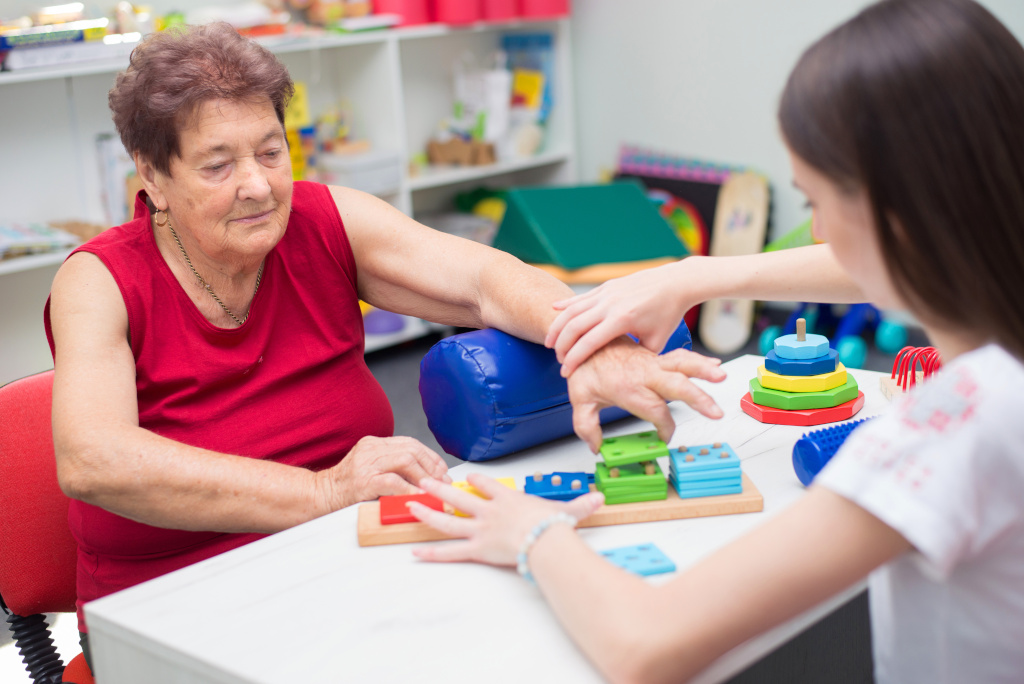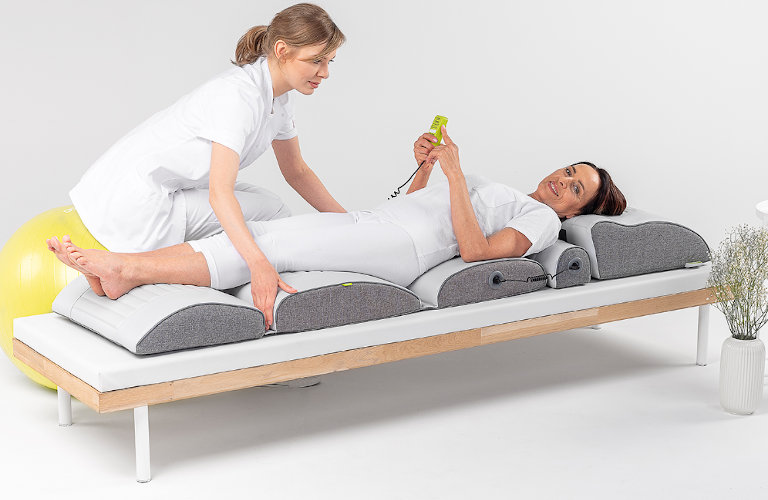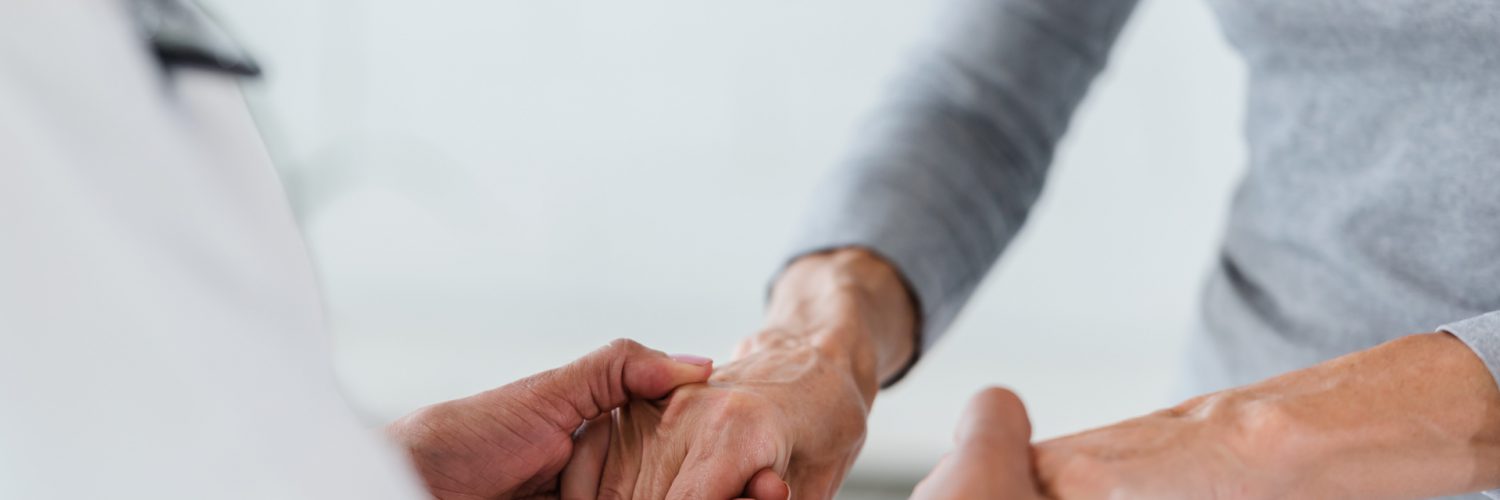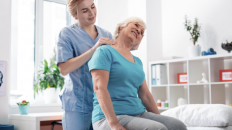Every year, about 90 000 people in Poland suffer a stroke, with up to 80% of all cases being so-called ischaemic strokes. The most common sequelae of a stroke are brain damage, circulatory insufficiency, epileptic seizures and paresis or excessive muscle tension, which is referred to as spasticity. Spasticity can occur especially in the upper limbs. In this article, we highlight the role of hand rehabilitation after stroke and explain when vibration therapy can help.
Hand spasticity after stroke
One of the most important factors in the treatment of post-stroke patients is time. The sooner the right therapy is implemented, the better the chances that the patient will be able to return to independent functioning. This is also very important for hand rehabilitation after stroke.
The most common effect of stroke is spasticity, which is a painful spasm of a permanent nature that makes movement and daily activities difficult or completely impossible. In the case of hand spasticity, patients are most commonly seen with a clenched fist, an excessively bent elbow or wrist, and a pinched arm.
In these cases, it is essential to implement the appropriate treatment and rehabilitation as soon as possible, because spasticity of the upper limb can lead to venous thrombosis, infection, permanent contractures or joint deformities.A characteristic feature of spasticity is that the discomfort decreases during sleep and when the limb is at rest. It is worth adding that spasticity can be caused not only by physical strain, but also by factors such as exhaustion, stress or strong emotions.In the case of spasticity of the upper limb, rehabilitation is particularly necessary for the hand, because it is the hand that performs many precise movements and at the same time is subject to the greatest tension, even when gently trying to open a hand clenched into a fist.

Hand rehabilitation after stroke – the most popular methods
There is no single effective method for dealing with spasticity. We now know of many methods for hand rehabilitation after stroke.One of the most commonly used methods is PNF, or proprioceptive neuromuscular movement facilitation. It is one of the kinesiotherapy methods that is mainly used for neurological patients because it does not target a specific body part, but treats the patient’s body holistically in an attempt to restore overall mobility. It can be said that PNF is based on re-learning the body of specific movement patterns. This not only improves the patient’s overall balance and coordination, but also increases the range of movement as well as muscular strength and endurance.It is also very important to implement a variety of exercises, both those performed under the guidance of an experienced physiotherapist and those performed independently at home. The most common are manipulation exercises, i.e. virtually all movements that can be performed with the hand, such as grasping, wrist and finger movements, writing with a pen and many other everyday activities.

Mirror therapy, which takes its name from the use of a mirror, is also one of the methods of hand rehabilitation after stroke. The prerequisite for the implementation of this method is a healthy other hand, as the patient’s main task is to observe the healthy limb moving in the mirror, thus creating the illusion that the sick limb is actually healthy, and thus stimulating the so-called mirror neurons. Importantly, the advantage of this method is the possibility to exercise independently at home.Similar to PNF, another method that is based on exercising the whole body and not just a selected limb or part of it is NDT-Bobath. A very important element of the therapy is the assumption of brain plasticity and the elimination of abnormal sensory processing. With this method, the patient performs more and more movements over the course of the therapy, and each movement enables the patient to have further daily activities.
How can vibrotherapy support hand rehabilitation after stroke?
Vibrotherapy for the treatment of spasticity is a relatively new method of rehabilitation, although more and more studies are emerging every year confirming its high effectiveness.
One such study was conducted by Italian researchers, who demonstrated that the application of high-frequency local vibration therapy significantly improved, among other things, grip strength in the affected hand, reduced spasticity, and had a positive effect on dexterity and daily functioning in the subjects. In addition, patients who received this method complained less about pain. The researchers thus proved that the application of local vibrotherapy during voluntary muscle contraction influences excitability changes in the motor cortex. This, in turn, contributes directly to the reduction of muscle tension.It turns out that each receptor is sensitive to a different frequency of vibration. In the case of Meissner’s corpuscles, it is about 40 Hz, and mechanoreceptors (Vater-Pacini corpuscles) about 100 Hz. At the same time, vibrotherapy using higher frequencies also has a beneficial effect in rehabilitating the hand after a stroke, as they inhibit the muscle antagonistic to the tense muscle, while lower frequencies relax the spastic muscle.
 A somewhat similar study was decided by US researchers from Stanford University. They invited people who had suffered a stroke to take part in their study, designing a special glove for them that provided mechanical vibro-touch stimulation (VTS). Participants in the experiment were asked to wear this special vibrating glove eight weeks for three hours a day. Once a week, the patients’ hand function was tested, assessing, among other things, the level of spasticity and the perception of pressure on the skin. Interestingly, the glove was designed in such a way that patients could wear it at home while carrying out their daily activities.The results of the study showed very promising results. It turned out that post-stroke patients who received vibration therapy saw an improvement in cutaneous tactile perception, a reduction in finger spasticity, and an increase in range of movement in the fingers, elbow and arm.
A somewhat similar study was decided by US researchers from Stanford University. They invited people who had suffered a stroke to take part in their study, designing a special glove for them that provided mechanical vibro-touch stimulation (VTS). Participants in the experiment were asked to wear this special vibrating glove eight weeks for three hours a day. Once a week, the patients’ hand function was tested, assessing, among other things, the level of spasticity and the perception of pressure on the skin. Interestingly, the glove was designed in such a way that patients could wear it at home while carrying out their daily activities.The results of the study showed very promising results. It turned out that post-stroke patients who received vibration therapy saw an improvement in cutaneous tactile perception, a reduction in finger spasticity, and an increase in range of movement in the fingers, elbow and arm.
Particularly beneficial effects can be achieved by using vibrotherapy together with additional hand exercises to improve the hand’s motor skills. The study, published in the American Journal of Physical Medicine & Rehabilitation, involved forty-five stroke survivors who were subjected to vibrotherapy alone or vibrotherapy combined with upper limb exercises for a period of four weeks. The researchers noted that patients subjected to these methods showed significantly greater improvement than patients in the so-called control group. The latter showed a change of 3.22, compared to 12.6 for those using vibrotherapy, while the group of people who used vibrotherapy combined with exercise showed an improvement of 15.66. Ranges of movement also improved significantly, for example in interactions with objects (lifting, arranging items). Vibrotherapy and exercise resulted in a decrease in spasticity and an increase in hand grip strength by up to 31%.
Vitberg RS Hand Module – effective hand vibration therapy after stroke
For many stroke patients, every time they leave the house is a big problem. Given that these are often elderly people, it is hardly surprising that they often neglect the therapy or do not use it long enough. Vibration therapy, however, is not only effective, but also simple and can be applied even in the comfort of one’s own home.

Vitberg devices, which generate vibrations at specific frequencies, are used for this purpose, among others. The developers of the device also thought about patients with hand spasticity after a stroke. Specifically for them – and other people with upper limb problems – theHands Module was developed, which improves hand function by increasing muscle strength, improving joint mobility, as well as relaxing muscles, improving blood circulation and having an anti-spastic effect. This module acts as a clinical complement to the Back Module. It uses vibration at a frequency of 10-40 Hz, which has a very beneficial effect especially for chronic patients, including stroke survivors.
References:
Costantino C., Galuppo L., Romiti D. Short-term effect of local muscle vibration treatment versus sham therapy on upper limb in chronic post-stroke patients: a randomized controlled trial, European Journal of Physical and Rehabilitation Medicine, 2017 Feb;53(1):32-40.
Seim CE, Wolf SL, Starner TE., Wearable vibrotactile stimulation for upper extremity rehabilitation in chronic stroke: clinical feasibility trial using the VTS Glove, Journal of NeuroEngineering and Rehabilitation 2021 Jan 23;18(1):14.
Jung-Sun Lee, Chang-Yong Kim, Hyeong-Dong Kim, Short-Term Effects of Whole-Body Vibration Combined with Task-Related Training on Upper Extremity Function, Spasticity, and Grip Strength in Subjects with Poststroke Hemiplegia A Pilot Randomized Controlled Trial., American Journal of Physical Medicine & Rehabilitation, 01 Aug 2016, 95(8):608-617.




